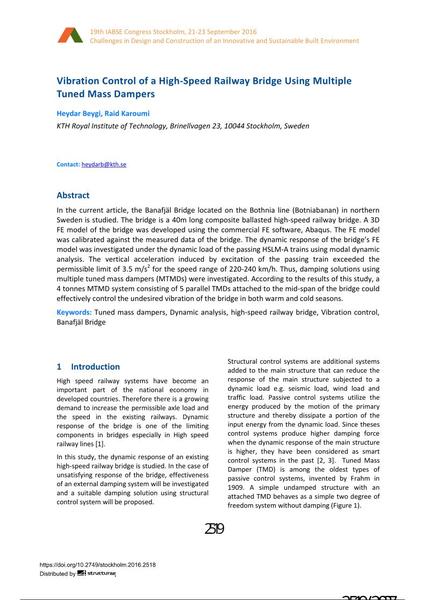Vibration Control of a High-Speed Railway Bridge Using Multiple Tuned Mass Dampers

|
|
|||||||||||
Bibliografische Angaben
| Autor(en): |
Heydar Beygi
(KTH Royal Institute of Technology, Brinellvagen 23, 10044 Stockholm, Sweden)
Raid Karoumi (KTH Royal Institute of Technology, Brinellvagen 23, 10044 Stockholm, Sweden) |
||||
|---|---|---|---|---|---|
| Medium: | Tagungsbeitrag | ||||
| Sprache(n): | Englisch | ||||
| Tagung: | IABSE Congress: Challenges in Design and Construction of an Innovative and Sustainable Built Environment, Stockholm, Sweden, 21-23 September 2016 | ||||
| Veröffentlicht in: | IABSE Congress Stockholm, 2016 | ||||
|
|||||
| Seite(n): | 2519-2526 | ||||
| Anzahl der Seiten (im PDF): | 8 | ||||
| Jahr: | 2016 | ||||
| DOI: | 10.2749/stockholm.2016.2518 | ||||
| Abstrakt: |
In the current article, the Banafjäl Bridge located on the Bothnia line (Botniabanan) in northern Sweden is studied. The bridge is a 40m long composite ballasted high-speed railway bridge. A 3D FE model of the bridge was developed using the commercial FE software, Abaqus. The FE model was calibrated against the measured data of the bridge. The dynamic response of the bridge’s FE model was investigated under the dynamic load of the passing HSLM-A trains using modal dynamic analysis. The vertical acceleration induced by excitation of the passing train exceeded the permissible limit of 3.5 m/s2 for the speed range of 220-240 km/h. Thus, damping solutions using multiple tuned mass dampers (MTMDs) were investigated. According to the results of this study, a 4 tonnes MTMD system consisting of 5 parallel TMDs attached to the mid-span of the bridge could effectively control the undesired vibration of the bridge in both warm and cold seasons. |
||||
| Stichwörter: |
dynamische Berechnung Eisenbahnbrücke für Hochgeschwindigkeitsbetrieb
|
||||

